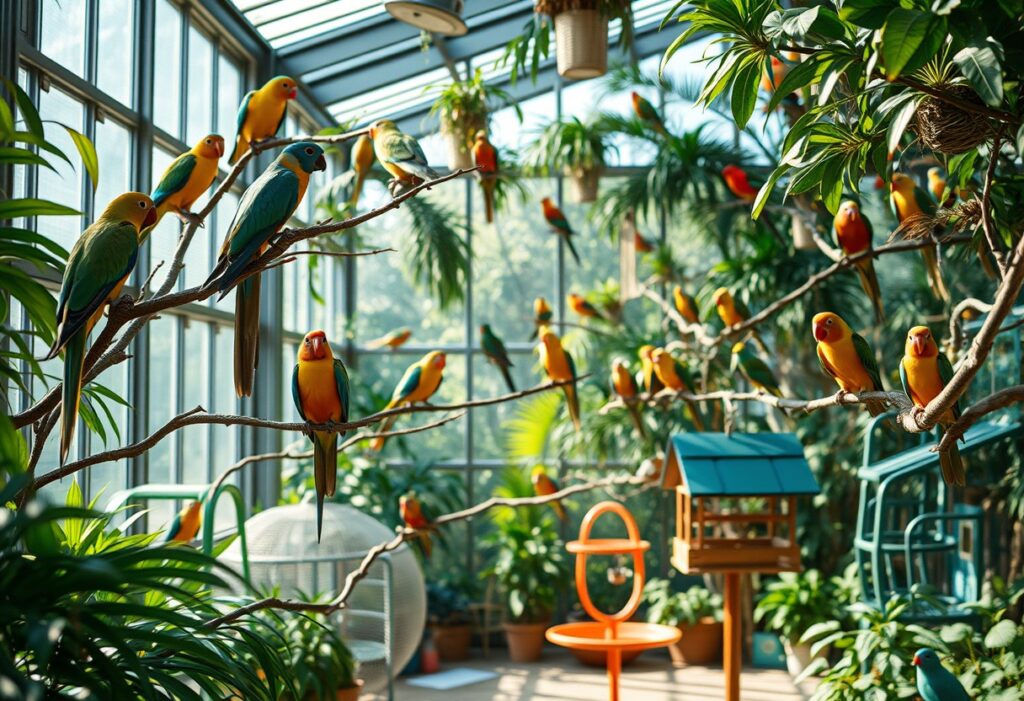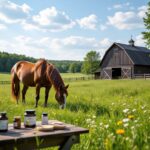Environment plays a crucial role in sustaining bird populations and their diverse behaviors. By ensuring a healthy environment, you not only promote the survival of various species but also contribute to their vital roles in ecosystems, such as pollination and pest control. Staying aware of the dangers posed by habitat destruction, pollution, and climate change is necessary, as these factors can severely impact their well-being. Understanding how your actions can foster a more positive habitat for birds will ultimately benefit both you and the natural world around you.
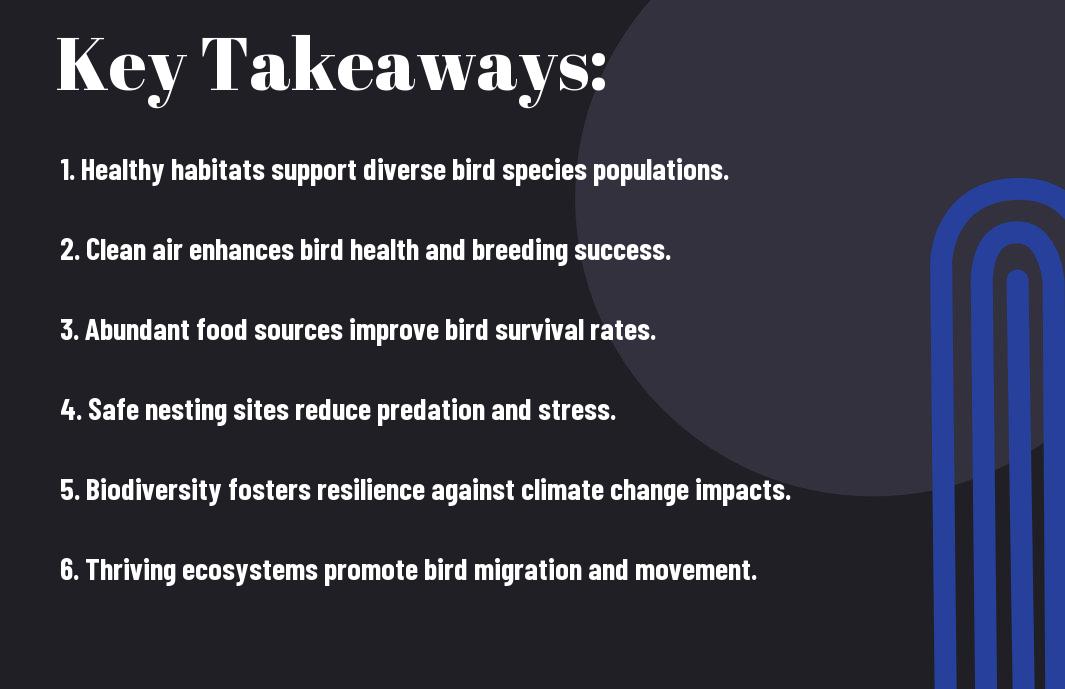
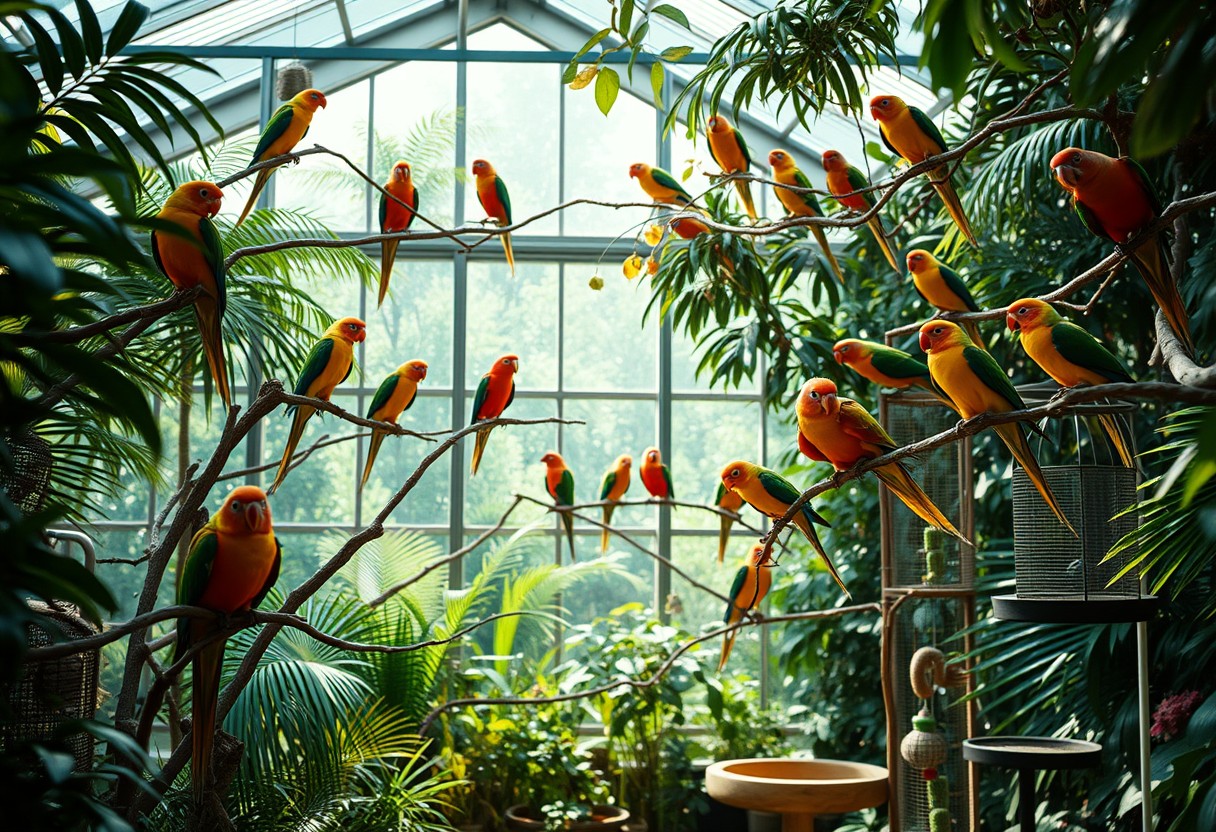
Importance of Habitat
While many people may overlook the significance of habitat in bird conservation, it plays a crucial role in their survival and well-being. A suitable habitat provides birds with imperative resources such as food, shelter, and nesting sites. By prioritizing healthy environments, you are not only increasing the chances of local bird populations thriving but also ensuring that various species can coexist and maintain balance within their ecosystems.
Natural Ecosystems
Ecosystems are intricate networks where each component, from flora to fauna, interacts with one another. For birds, a well-functioning natural ecosystem ensures an adequate supply of food sources, including seeds, insects, and fruits. The presence of diverse vegetation is vital; it offers cover from predators and nesting sites for reproduction. A disruption in these ecosystems can negatively impact bird species, leading to declines or even local extinctions.
Moreover, natural ecosystems contribute to climate stability, water purification, and soil preservation, all of which are crucial for maintaining the habitat where birds thrive. Consequently, you should advocate for the protection of wetlands, forests, and grasslands, as these areas serve as imperative habitats for many bird species. Understanding the interconnectedness of these ecosystems can lead you to support initiatives aimed at preserving and restoring these environments.
Urban Green Spaces
The significance of urban green spaces cannot be overstated when considering bird habitats in increasingly built environments. These areas, which include parks, gardens, and landscaped areas, provide valuable refuge for birds amidst the urban sprawl. By incorporating native plants and trees in your outdoor spaces, you can create habitats that attract birds and foster biodiversity. Additionally, urban green spaces serve as critical stopover points for migratory birds, offering them a place to rest and refuel during their journeys.
Understanding the role of urban green spaces means recognizing that they can mitigate some of the challenges faced by birds in urban settings. By ensuring that these areas remain safe and accessible, you contribute to the overall health of bird populations. Your involvement in promoting and maintaining these spaces can aid in counteracting habitat loss caused by urban development and enhance community engagement with nature, ultimately benefiting local birdlife.
Impact on Bird Health
Little do many realize that a healthy environment plays a crucial role in the overall well-being of bird populations. Your actions can have a direct impact on bird health, and by fostering a suitable habitat, you can contribute to the thriving of local avian species. This benefits not just the birds but also enhances the ecological balance, which in turn supports a diverse range of wildlife.
Reducing Disease Spread
Impact on bird health can be seen significantly in the reduction of disease spread through a clean and resource-rich environment. Contaminated habitats can facilitate the transmission of diseases among bird populations, leading to substantial declines. By maintaining a clean habitat, you can help minimize the risks of disease outbreaks that could devastate local species.
Creating an environment that includes natural food sources, clean water, and shelter can significantly help in virus and parasite control. You have the power to reduce density and improve environmental conditions—both of which are key factors that help to limit the spread of avian diseases. This is particularly important as bird populations face increased health risks due to habitat destruction and pollution.
Enhancing Nutrition
The nutrition available in a healthy environment is vital for birds to thrive. When you take steps to ensure that their habitat is rich in native plants and natural food sources, you support their dietary needs. A well-nourished bird is more capable of withstanding environmental stressors, reproducing successfully, and maintaining a robust immune system. Thus, an enriched habitat translates directly to improved nutrition and overall health for local bird populations.
Understanding the relationship between a healthy environment and bird nutrition highlights the importance of providing native flora that offers rich, diverse food sources for these creatures. For instance, plants that produce seeds, fruits, and nectar are necessary for various bird species. By planting native species in your garden or community spaces, you not only enhance the landscape but also ensure that the birds have constant access to high-quality nutrition, thus fostering sustainable bird populations and increasing their health, vitality, and resilience against environmental changes.
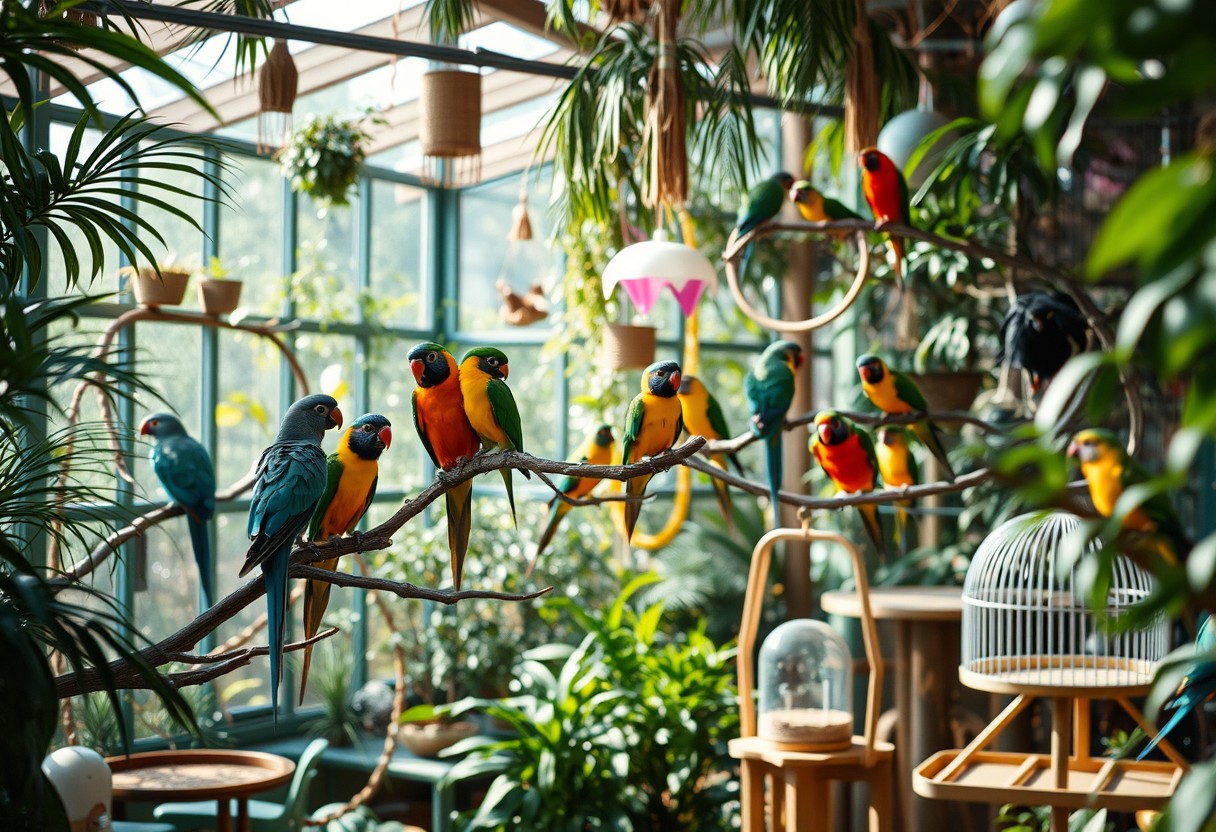
Biodiversity and Bird Populations
Despite the challenges faced by bird populations worldwide, a healthy environment plays a pivotal role in promoting biodiversity that directly impacts these avian species. Biodiversity, which refers to the variety of life forms within a particular habitat or ecosystem, is critical for maintaining the delicate balance needed for all species to thrive. When you support a diverse ecosystem, you not only help birds by providing them with food sources and nesting habitats, but you also enhance the overall resilience of your local environment, making it more capable of withstanding environmental changes and threats.
Supporting Species Diversity
An abundance of species contributes to a rich tapestry of life. When you foster a healthy environment, you ensure that various species of plants and insects thrive, ultimately supporting the birds that rely on them for sustenance and shelter. Diverse ecosystems create a web of interdependence – when the plant life is robust, it attracts insects, which in turn attract birds. By improving your local habitat through conservation efforts or simply by planting native flora, you can play an imperative role in the survival of local bird populations.
Effects of Invasive Species
For bird populations, the presence of invasive species can lead to significant challenges that jeopardize their survival. Invasive plants and animals often outcompete native species for resources, leading to a decrease in food availability and nesting sites for birds. This can drastically alter the dynamics within local ecosystems, ultimately resulting in a decline in bird populations. When you recognize the threats posed by invasive species, you can take steps toward supporting not only your local birds but also the entire ecosystem.
Biodiversity is imperative for maintaining the health of ecosystems, and the effects of invasive species can severely disrupt this balance. Invasive species can introduce diseases, alter habitats, and diminish food sources, leading to a decline in native bird populations and the loss of their unique behaviors and ecological roles. As a responsible steward of your environment, you can help mitigate these impacts by participating in local conservation efforts, controlling invasive species, and promoting the growth of native species, thereby ensuring a thriving habitat for birds and other wildlife.
Conservation Efforts
Once again, the importance of conservation efforts cannot be overstated when it comes to creating and maintaining a healthy environment for birds. Birds face numerous challenges in their habitats, including habitat destruction, climate change, and pollution. Your involvement and the broader community’s efforts are crucial in combating these threats and ensuring that various bird species thrive in their natural ecosystems. From local initiatives to global treaties, every action counts in the relentless task of conserving these beautiful creatures and their environments.
Community Involvement
The success of conservation efforts often relies heavily on community involvement. When you participate in local birdwatching groups, habitat restoration projects, or educational programs, you not only gain knowledge about local species but also contribute actively to their preservation. Engaging with your community can elevate awareness regarding the preservation of local ecosystems and foster a sense of responsibility towards the birds that inhabit them. Such grassroots initiatives lead to impactful changes that can drastically improve habitats, benefiting both birds and other wildlife.
Moreover, community involvement can create a network of individuals who share your passion for birds and conservation. Organizing workshops, clean-up drives, or tree-planting events encourages collective action, which enhances the quality of environments that birds depend on. By collaborating with like-minded individuals, you become part of a larger movement that raises awareness about the importance of protecting avian habitats, ensuring that future generations can also enjoy the beauty and diversity of birds.
Policy and Regulation
To enhance conservation efforts, strong policies and regulations play a pivotal role in safeguarding bird habitats. These regulations are designed to limit detrimental activities like deforestation, pollution, and urbanization that threaten bird populations. By advocating for and supporting policies that aim to protect avian interests, you help create an enabling environment for sustainable practices that prioritize both human and ecological needs. Regulations can include protected areas, migratory bird treaties, and biodiversity conservation laws that align with your commitment to a healthier world for birds.
With effective policy implementation, critical habitats for birds can be preserved or restored, thus allowing populations to flourish. For instance, the establishment of protected areas ensures that necessary habitats remain untouched by development, providing safe nesting grounds for various species. Additionally, regulations on pollution and pesticide use help maintain the integrity of these environments, further supporting avian life. By educating yourself on these policies and advocating for their compliance, you can play a significant role in the conservation narrative, contributing to a more sustainable future for your feathered friends.
Summing Up
The benefits of a healthy environment for birds extend far beyond the avian population; they also significantly enrich your local ecosystem and ultimately enhance your quality of life. By providing clean air, sufficient water, and ample food sources, you’re not just supporting birdlife; you’re also contributing to the broader health of the environment. Healthy habitats enable birds to thrive, which in turn aids in pest control, seed dispersal, and pollination. Additionally, witnessing a vibrant bird population can offer you unique opportunities for connection and enjoyment in nature, making your surroundings more dynamic and engaging.
As you take steps to foster a healthier environment for birds, you participate in a larger movement toward ecological sustainability. This will not only benefit the feathered friends around you but also promote biodiversity, improve air quality, and create more resilient ecosystems. Whether it’s planting native vegetation, minimizing pesticide use, or preserving natural habitats, your efforts can lead to tangible changes that support conservation. Ultimately, when you prioritize a healthy environment for birds, you are investing in a legacy of ecological balance that benefits both wildlife and your community, ensuring that future generations can enjoy the rich tapestry of life that birds provide.
FAQ
Q: What are the primary benefits of a healthy environment for birds?
A: A healthy environment provides crucial resources such as clean water, abundant food, and suitable nesting sites, which are crucial for the survival and reproduction of birds. Clean habitats help reduce the risk of disease, while diverse ecosystems contribute to a stable food supply, ensuring that birds can thrive. Additionally, healthy environments encourage biodiversity, which supports various species interactions that are crucial for ecosystem balance.
Q: How does pollution affect bird populations?
A: Pollution, whether from chemicals, litter, or noise, poses significant threats to bird populations. Contaminants in the air, water, and soil can lead to health issues in birds, impacting their ability to reproduce and survive. For instance, exposure to pesticides can harm their reproductive system, while plastic waste can lead to ingestion hazards. Moreover, noise pollution can interfere with communication and mating rituals, leading to stress and habitat abandonment.
Q: What steps can individuals take to create a healthier environment for birds?
A: Individuals can take several steps to promote a healthier environment for birds, including creating bird-friendly gardens with native plants that provide food and shelter. Reducing pesticide use and opting for organic gardening methods help protect birds from harmful chemicals. Additionally, maintaining clean habitats by properly disposing of waste and supporting local conservation efforts can significantly benefit avian populations. Lastly, using birdhouses and feeders can offer safe havens and supplemental feeding opportunities to attract and support local birds.
